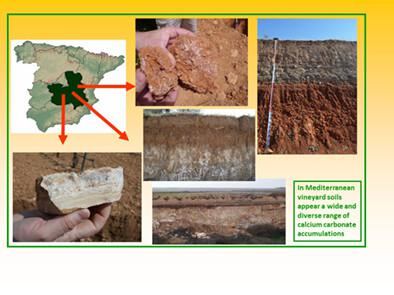当前位置:
X-MOL 学术
›
Eur. J. Soil Sci.
›
论文详情
Our official English website, www.x-mol.net, welcomes your feedback! (Note: you will need to create a separate account there.)
Carbonate morphological features of vineyard soils in a semiarid Mediterranean environment
European Journal of Soil Science ( IF 4.2 ) Pub Date : 2023-11-13 , DOI: 10.1111/ejss.13435 R. Jiménez‐Ballesta 1 , S. Bravo 2 , C. Pérez‐de‐los‐Reyes 2 , J. A. Amorós 2 , F. J. García‐Navarro 2
European Journal of Soil Science ( IF 4.2 ) Pub Date : 2023-11-13 , DOI: 10.1111/ejss.13435 R. Jiménez‐Ballesta 1 , S. Bravo 2 , C. Pérez‐de‐los‐Reyes 2 , J. A. Amorós 2 , F. J. García‐Navarro 2
Affiliation

|
Many vineyard soils in semiarid Mediterranean environments develop from carbonated materials and often show very diverse forms of pedogenic calcium carbonate accumulations. Based on 275 vineyard soil profiles in the Castilla La Mancha (CLM) territory (Spain), this paper presents an in-depth comprehensive study of a large number of morphological expressions of these carbonate distributions, while exploring various pedogenesis formation hypotheses. The interactions among the calcareous nature of parent material, surface topography and climate are the factors that most affected their morphology and pedogenesis. The occurrence and distribution of carbonate features in CLM vineyard soils can be more complex than in other areas. Many accumulations are relatively ancient, which is the case of petrocalcic horizons, and in-keeping with conservative means, which reveals the occurrence of successive carbonate accumulation cycles. More recently dissolved and precipitated seasonally pedogenic carbonates (sometimes as coatings) have appeared, which are nothing more than a simple recent redistribution of carbonates. A structural imprint is observed: pedogenic carbonates appeared much more abundantly on the lowermost horizons, which can be related to the repeated redistribution phases that occurred in different pedogenesis stages. The data provided herein help to improve the understanding of the nature of viticultural calcareous soils in semiarid Mediterranean regions.
中文翻译:

半干旱地中海环境葡萄园土壤碳酸盐形态特征
半干旱地中海环境中的许多葡萄园土壤都是由碳酸物质发展而来的,并且经常表现出非常多样化的成土碳酸钙积累形式。本文以西班牙卡斯蒂利亚拉曼恰(CLM)地区的275个葡萄园土壤剖面为基础,对这些碳酸盐分布的大量形态表现进行了深入综合研究,同时探索了各种成土形成假说。母质的钙质性质、表面地形和气候之间的相互作用是对其形态和成土作用影响最大的因素。CLM 葡萄园土壤中碳酸盐特征的发生和分布可能比其他地区更为复杂。许多堆积物相对古老,岩钙层就是一个例子,并且与保守方法一致,这揭示了连续的碳酸盐堆积旋回的发生。最近出现了溶解和沉淀的季节性成土碳酸盐(有时作为涂层),这只不过是碳酸盐最近的简单重新分布。观察到结构印记:成土碳酸盐在最低层出现得更加丰富,这可能与不同成土阶段发生的重复的重新分布阶段有关。本文提供的数据有助于提高对半干旱地中海地区葡萄栽培钙质土壤性质的了解。
更新日期:2023-11-13
中文翻译:

半干旱地中海环境葡萄园土壤碳酸盐形态特征
半干旱地中海环境中的许多葡萄园土壤都是由碳酸物质发展而来的,并且经常表现出非常多样化的成土碳酸钙积累形式。本文以西班牙卡斯蒂利亚拉曼恰(CLM)地区的275个葡萄园土壤剖面为基础,对这些碳酸盐分布的大量形态表现进行了深入综合研究,同时探索了各种成土形成假说。母质的钙质性质、表面地形和气候之间的相互作用是对其形态和成土作用影响最大的因素。CLM 葡萄园土壤中碳酸盐特征的发生和分布可能比其他地区更为复杂。许多堆积物相对古老,岩钙层就是一个例子,并且与保守方法一致,这揭示了连续的碳酸盐堆积旋回的发生。最近出现了溶解和沉淀的季节性成土碳酸盐(有时作为涂层),这只不过是碳酸盐最近的简单重新分布。观察到结构印记:成土碳酸盐在最低层出现得更加丰富,这可能与不同成土阶段发生的重复的重新分布阶段有关。本文提供的数据有助于提高对半干旱地中海地区葡萄栽培钙质土壤性质的了解。



























 京公网安备 11010802027423号
京公网安备 11010802027423号